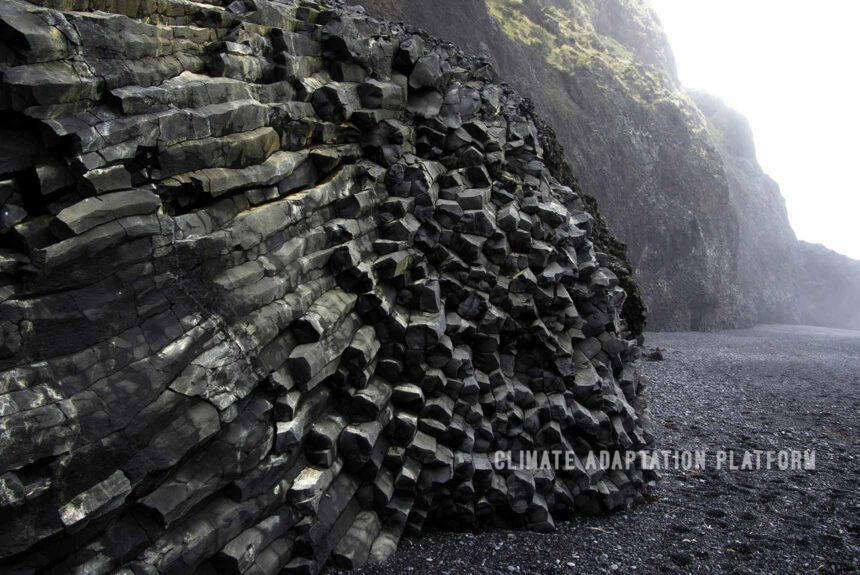Reducing greenhouse gas emissions alone will not be enough to stop dangerous levels of warming and wound need some carbon dioxide removal – actively taking it out of the atmosphere.
Climate science assessments from the IPCC say that we will need a large-scale carbon dioxide removal in the second half of the century to avoid exceeding the 1.5°Cwarming limit unless we reduce our emissions in half by 2030.
One of the possible solutions to stabilise the Earth’s climate and to capture carbon dioxide directly from the atmosphere is using enhanced rock weathering.
This carbon capture tool lies somewhere in the middle of a natural and a man-made solution using tiny pieces of basalt rock or rocks rich in silicates and spreading them across large land areas. As these rocks break down, they react with rain and the atmosphere to capture and store carbon dioxide permanently.
Natural weathering has been nature’s way of stabilising the climate by regulating GHG emissions. But increasing fossil fuel emissions and GHG atmospheric concentrations would need to amplify the natural weathering process to remove and store carbon dioxide faster.
BBC reports of an enhanced rock weathering company, UNDO, in Scotland across the Firth of Forth from Edinburgh. The company gathers the tiny pieces of black basalt rocks left over from the quarry activities and spreads them on agricultural lands. It just secured £12m of new investment and is looking to scale up its operations.
The article says volcanic rock and cliffs have slowly captured carbon by weathering in the rain for millennia. But grinding these rocks into tiny pieces increases the contact between the rain and rocks, hence weathering.
Scattering these rocks on a farm field does not require specialist equipment but just the usual farm tractor and trailer. A farmer observed that it makes better grasses for the cattle.
However, scientists warn that carbon removal techniques could distract people from the urgency of reducing emissions.
As for the efficiency of rock weathering to capture carbon, UNDOs scientists calculate those four tonnes of basalt rocks capture one tonne of CO2. To put this into perspective, each Briton emits about 7 tonnes a year, meaning capturing all their emissions requires every one of them to scatter about thirty tonnes of tiny rocks annually.
UNDO seems unfazed by the math and has even attracted Microsoft to pay 25,000 tonnes of basalt to spread on UK soils. As part of the deal, Microsoft will get involved with the audit to ensure the project works as intended.
Inside Climate News presents studies on the factors that influence the efficiency of rock weathering and the type of climate that makes it more efficient in capturing carbon.
Research published in Science on January 2023 shows how effective rock weathering is in the real world on a global scale. The study finds that rock weathering captures more carbon dioxide in a warmer and wetter climate but says that it is not a silver bullet to stop global warming.
Author Bob Hilton from the University of Oxford wrote about how temperature affects the rate of rock weathering.
“This can be explained by an array of processes in landscapes, including physical mechanisms such as fracturing, the formation of new minerals during weathering, and the role of microorganisms”.
He also tweeted his explanation of the carbon cycle, its release and removal, and how erosion and rainfall increase CO2 removal by silicate weathering.
The article says that implementing enhanced rock weathering has some problems. First, it could increase mining activities to access these basalt or mineral-rich rocks. Second, it is essential to consider the impacts of trucks used to transport millions of tonnes of rocks, and thirdly, scattering these tiny pieces of rocks could send off plumes of dust that could be hazardous if inhaled.
Hilton says that although enhanced rock weathering may have a place in climate change mitigation, it is not a panacea to the climate crisis.
Other solutions to sequester carbon include significantly expanding forest areas around the world, fertilising parts of the ocean with minerals to boost plankton production, growing crops that capture carbon and can then be used to produce low-emission energy, as well as direct air capture, which uses industrial machinery to remove CO2 from the air with a chemical process, the article says.
Source:
Fisher, J. (2023 May 21). Can ‘enhanced rock weathering’ help combat climate change? BBC. Retrieved from https://www.bbc.com/news/science-environment-65648361
Berwyn, B. (2023, January 26). A Warmer, Wetter World Could Make ‘Enhanced Rock Weathering’ a More Useful Tool to Slow Climate Change. Inside Climate News. Retrieved from https://insideclimatenews.org/news/26012023/a-warmer-wetter-world-could-make-enhanced-rock-weathering-a-more-useful-tool-to-slow-climate-change
Hilton, R. G. (2023). Earth’s persistent thermostat. Science, 379(6630), 329-330.



Leave a Reply